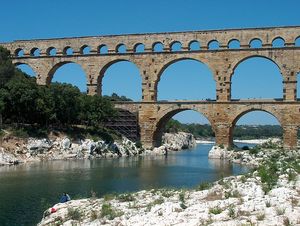Ancient Rome is arguably one of the world’s greatest civilizations. From the time of Christ forward about 500 years, the Roman Empire dominated much of Europe as well as parts of Africa and Asia. The History Channel purports Rome moved from a republic to an empire between the death of Julius Caesar in 44 BCE and the rise of Augustus Caesar in 27 BCE.
In order to have a formidable empire, the Romans had some amazing inventions. Here are five of them that still influence modern society.
Arches
Romans built impressive structures such as the Coliseum where gladiator fights and re-enactments of naval battles occurred. The large building needed something to hold all the weight of the bricks and mortar holding it together. The art of arches eventually went from practical to ornamental, according to Smith College’s Museum of Ancient Inventions.
Aqueducts were several stories high and need arches to support the weight. A keystone at the top of the arch shifted weight horizontally in two directions. The arches were then supported by columns.
Aqueducts
Aqueducts were primitive until Roman architects got a hold of them and improved the design. A report by Bucknell University states aqueducts before Roman times were made of earthen wells dug out of hills. Romans perfected the design by having channels of flowing water that moved several hundred miles to towns that needed water. Once inside cities, aqueducts delivered water via lead pipes. This Roman aqueduct website has a listing of over 600 different structures and statistics.
Concrete
The University of Minnesota reports concrete in Roman times was a mixture of lime, clay, sand and other materials. The substance was hardened by heat, according to the University of Minnesota. Structures built using concrete include the Pantheon which has a 75-foot-wide dome made with poured concrete. The term concrete is from the Latin “concretus” which means “grow together,” according to the National Institute of Standards and Technology (NIST).
Roads
The BBC states Roman roads were made with foundations of clay, gravel and chalk. Bricks and stones were overlayed on top. Roads were elevated in the middle so water would runoff to the sides. They were also wide enough to have chariots travel in two directions.
The Smith College Museum of Ancient Inventions purports a primitive steam engine was invented by Heron, an inventor who lived in Alexandria, Egypt. Called the “aeolipile,” or “air ball,” Heron created a sealed sphere of water that was heated by a flame. Two narrow pipes allowed the steam to escape which allowed the ball to rotate around like a jet engine. Although Heron felt his invention was a novelty toy, the same principles are used today as hot air is jetted out the back of engines to propel modern jet airplanes.
